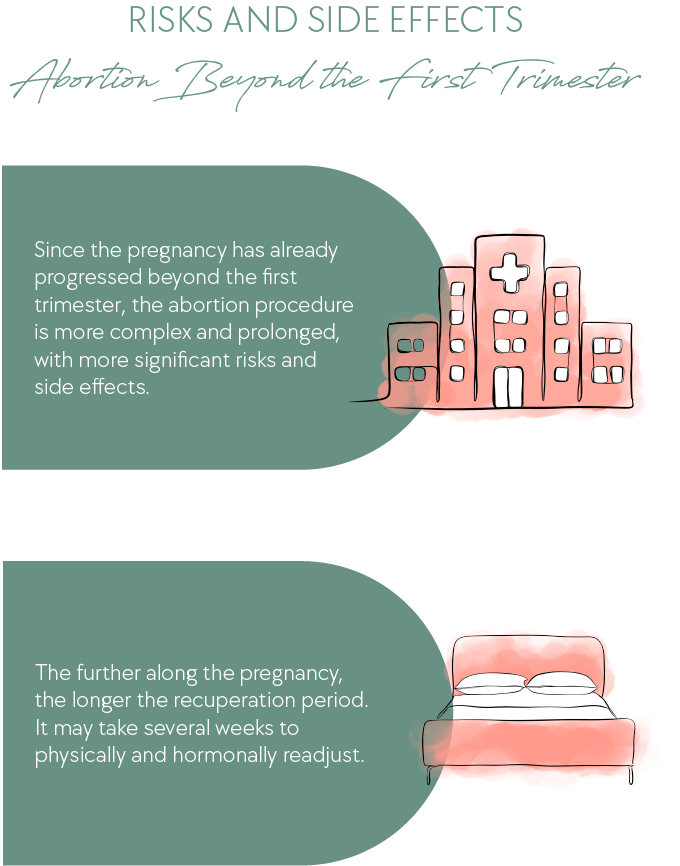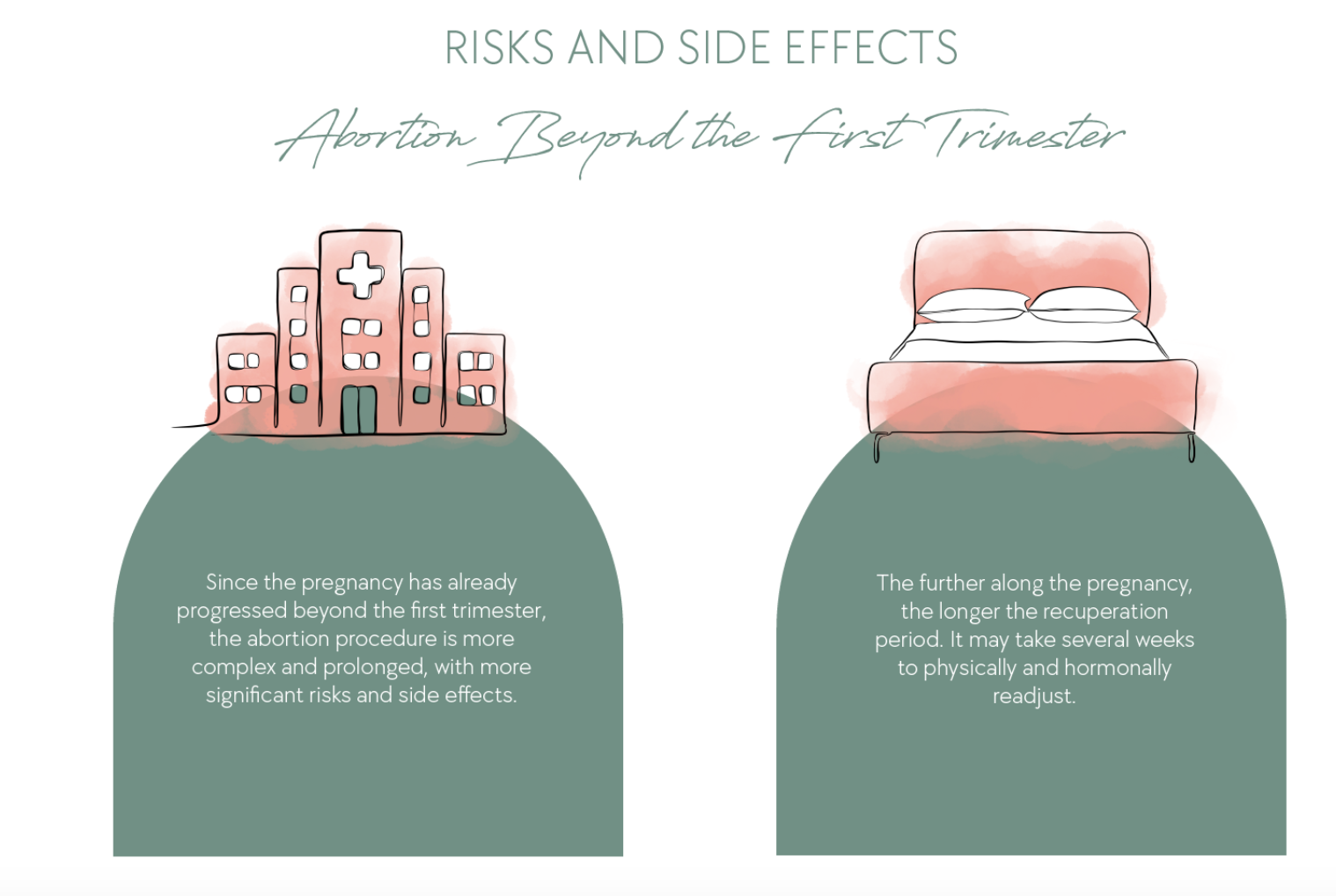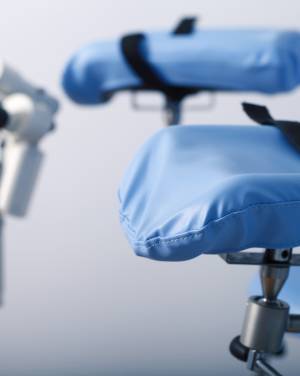Information on Abortion by D&E
🏥 Abortion Methods: What Do I Need to Know? — Quiz
- D&E is a surgical procedure combining dilatation, vacuum aspiration, forceps and curettage.
- It is the most common second-trimester abortion method and is also performed for an incomplete, late miscarriage.
- The risk of complications lies at 5%, which is slightly higher than first-trimester abortions, since risks increase with gestational age — e.g. injury to the uterus or cervix.
Abortion Methods: What Do I Need to Know? — Quiz
Considering abortion and want to know which methods are available to you? Answer three multiple-choice questions about your situation and receive a professional evaluation within seconds on your screen!
What Is a D&E Abortion (Dilatation and Evacuation Abortion)
Some surgical abortion methods, such as vacuum aspiration and D&C, can only be used until the 15th week of pregnancy. Later abortions require different methods because of foetal size. 94-98% of these are D&E abortions. During a D&E abortion, the foetus is dismembered using forceps for easier removal.
- Find out more about threshold restrictions by going to Until When Can I Get an Abortion?
- Go to Abortion Methods to see how the different methods compare.
- Go to Late-Term Abortion to learn about exceptions, regulations and procedures.
While D&Es are commonly done in a clinic, they can also be performed in a hospital.
- ℹ️ For more information on locations, go to Abortion Near Me.
A D&E abortion is usually an outpatient procedure. While the surgery takes only 30 minutes, the entire procedure is completed within two consecutive days.
These added procedural protocols increase the cost of an abortion.
- Wondering how much you can expect to pay? Go to How Much Does an Abortion Cost.
If you live in Northern Ireland and are considering a second-trimester abortion, abortion care can be accessed in Great Britain – the costs of which are covered by the NHS (including travel and accommodation expenses).
D&E Abortion: The Procedure
D&E abortions are completed in two steps on consecutive days:
1. Preparation Stage — Day 1
Consent Forms and Payment
By law, abortion is a free choice and may not be coerced. Therefore, abortions are only performed with the written permission of the woman.
- Go to Coerced Abortion if you feel pressured into having an abortion.
Bloodwork and Ultrasound
Before initiating dilatation, blood is drawn to determine your Rh factor and blood type in case the need for blood transfusions arises.
A pre-abortion ultrasound identifies how far along you are in the pregnancy and reveals the position of the foetus and placenta.
Foeticide
An injection to induce foetal demise is sometimes given through the woman's abdomen or cervix. This is an elective step.
Antibiotics
A single dose of oral antibiotics is given to prevent infection.
Dilatation
The cervix is softened and gradually dilated (opened) over a 24 hour period using osmotic dilators. Seaweed stalks (laminaria) or hydrogel rods are used for this purpose as they slowly expand by absorbing the moisture in the woman's cervix. After the placement of the dilators, the woman is free to leave the clinic until her appointment the following day.
2. Evacuation Stage — Day 2
Anaesthesia
D&Es are typically performed using a paracervical block (local anaesthetic injected into your cervix) and intravenous conscious sedation.
- Wondering what kind of sedation to use? Go to What Type of Anaesthesia?
Removal of Foetus and Placenta
The doctor uses a speculum to open the woman's vagina, making her cervix visible. A tube is inserted into her uterus, by which all amniotic fluid is suctioned out. Using forceps, the foetus is then dismembered and extracted in pieces. After the extraction, suction and curettage ensure that the uterus is completely emptied. An ultrasound is commonly used to confirm that the abortion is complete.
Recovery Room
Immediately after the procedure, the woman will be observed for an hour and given discharge instructions. A partner, friend, or family member will need to drive the patient home.
What to Expect After a D&E
Side Effects
After the procedure, vaginal bleeding can be expected for a few days or even up to two weeks. Cramping may continue for several weeks, causing the uterus to return to its pre-pregnancy size. Lactation is possible, causing breasts to swell, hurt and leak colostrum. Seek medical help if you are experiencing excessive bleeding or pain, running a high temperature, or feeling unsure about any side effects.
⚠️ Menstruation should resume after four to eight weeks, but conception is possible before your first period.
Things to Avoid
Since the cervix stays slightly open for three to four weeks, medical providers advise you to refrain from the following activities to avoid infection:
- sexual intercourse
- tampons
- swimming pools/baths
- sauna visits
Potential Risks of a D&E
Before the procedure, your doctor will inform you of the possible risks of a D&E abortion. Approximately 5% of women encounter complications such as retaining foetal tissue (1%), cervical laceration (3%), uterine perforation, infection (0.1-4%), extramural delivery (delivery due to dilatation before the surgery) and haemorrhage (>1%).


ℹ️ For more information, go to Risks and Side Effects of Abortion.
Apart from considering the physical risks, stay in tune with your heart and mind to evaluate whether this is the right path for you. In counselling, we regularly encounter women who struggle with their choice after having had an abortion. Therefore, it is crucial that you take the time you need. If you feel uneasy about having a D&E and unsure whether this is the path for you, pay attention to your intuition. You are not obligated to keep your appointment.
Reasons for a D&E Abortion
The reasons women pursue D&E abortions are as unique as their lived experiences.
Perhaps you have received the heartbreaking news of a foetal anomaly and are wondering whether to have an abortion.
- Use our Foetal Defect Abortion Test to guide you in the decision-making process.
Maybe you are encountering a severe medical issue that is putting your life or health at risk.
- Use the information provided in Abortion for the Health of the Mother as you determine your next steps.
Perhaps you just found out you were pregnant, or you could not get an appointment sooner because of finances or abortion restrictions.
Or maybe you are experiencing an unexpected crisis in your relationship, causing you to doubt whether you should continue the pregnancy.
Where to Go from Here?
Your questions go far beyond investigating which abortion method to use. Any of these situations would bring an overload of thoughts and emotions. It would be hard to know where to start.
Take a deep breath! You usually do not have to decide on the spot, even if your doctor makes it sound that way. An abortion at a later stage of pregnancy can be an agonising experience. Therefore, it is crucial to explore your options. Unless you are experiencing a medical emergency, you are probably given ample time to consider your next steps and determine which path is most in line with who you are.
Allow us to remove some of the confusion by assisting you in ordering your thoughts.
Our unbiased digital coaching tools were created by professional counsellors with your situation in mind. Why not give them a try?
- ⛑ Wondering where to go from here? Take the First Aid Test
- ⚖️ Wondering whether to have an abortion or not? Take the Abortion Test
- 💡 Concerned about a specific issue? Take the Solutions Finder Test










